Moroccan design brings an exotic, warm, and enchanting atmosphere to any space with its rich colors, intricate patterns, and mesmerizing textures.
The perfect blend of Arabian, Mediterranean, and African influences creates a unique aesthetic that can transport you straight to the vibrant markets of Marrakech.
Adding Moroccan elements through lanterns and textiles is one of the easiest ways to infuse your home with global charm without a complete renovation.
Statement Pendant Lanterns That Transform Ceilings into Art
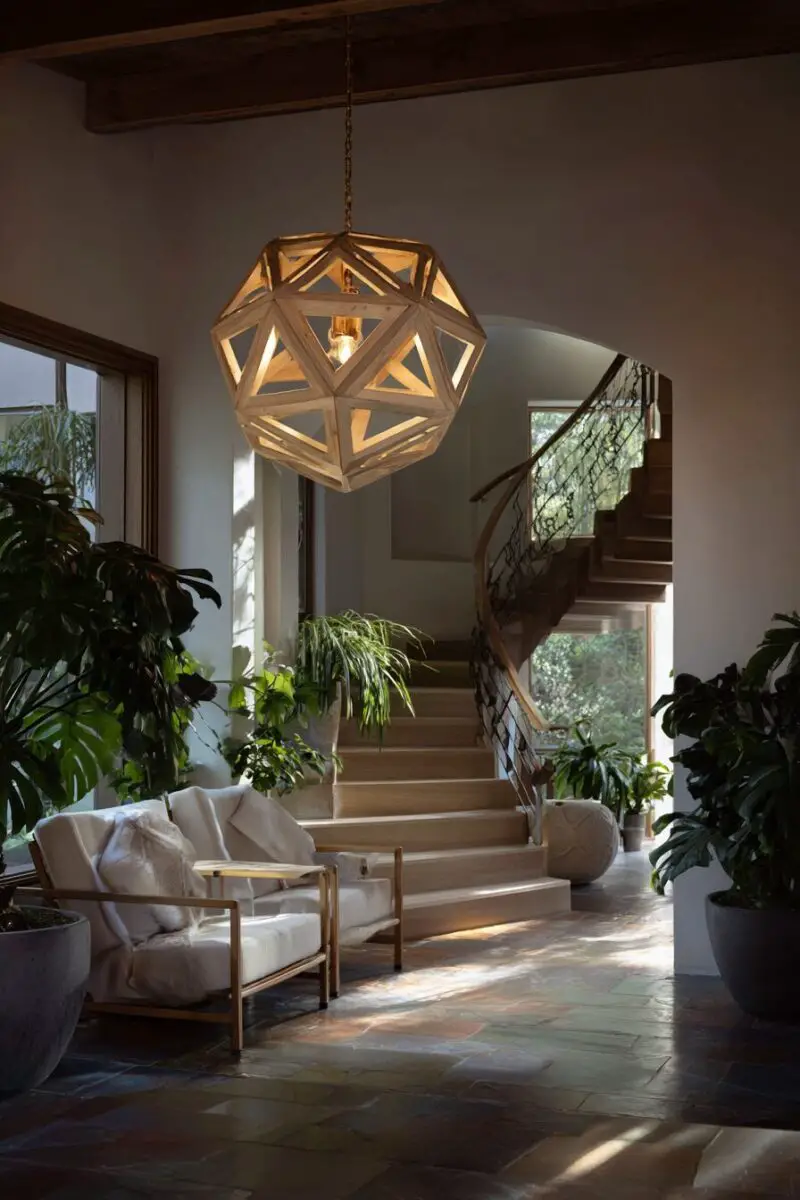
Nothing captures Moroccan elegance quite like a large, intricately patterned metal pendant lantern hanging from your ceiling.
These showstopping pieces cast mesmerizing shadow patterns across your walls and ceiling, creating an instant atmosphere of exotic luxury.
You can install one large statement lantern in your entryway to greet guests with a dramatic first impression that sets the tone for your entire home.
For dining areas, hanging a Moroccan pendant at varying heights creates an intimate restaurant-like experience that will elevate every meal.
The filigree metalwork of authentic Moroccan lanterns is traditionally handcrafted by skilled artisans who punch tiny holes in brass, copper, or silver-plated metal to create geometric patterns.
When selecting your statement piece, consider the metallic finish that complements your existing décor—oxidized brass for a vintage feel, polished silver for a more contemporary look, or copper for warm, rustic charm.
Size matters with these statement pieces—go larger than you initially think appropriate, as Moroccan design embraces boldness and these lanterns are meant to command attention.
The colored glass panels found in many Moroccan lanterns add another dimension, filtering light through jewel tones of ruby, emerald, amber, and sapphire.
You can wire these lanterns directly into your ceiling or opt for plug-in versions that can be hung from hooks for a less permanent installation.
For maximum impact, install a dimmer switch to control the intensity of the light, allowing you to shift from practical illumination to a soft, romantic glow.
Madison’s Current Obsessions
Bring Life to Shadowy Spaces: 11+ Low-Light Houseplants for Your HomeLayered Textile Magic: Rugs That Tell Stories Underfoot

Moroccan rugs aren’t just floor coverings—they’re storytelling pieces woven with centuries of cultural heritage and artistic tradition.
The iconic Beni Ourain rugs, with their cream backgrounds and simple black geometric patterns, add instant sophistication to modern and traditional spaces alike.
You can layer multiple Moroccan rugs of different styles, sizes, and patterns to create a rich, collected-over-time look that feels both curated and effortlessly bohemian.
For smaller spaces, consider Kilim rugs with their flat-woven technique and bold geometric patterns that add color without bulk.
Authentic Moroccan rugs are handmade from natural materials like wool, making them not just beautiful but incredibly durable investments that actually look better with age and wear.
The asymmetrical patterns and slight imperfections in handwoven Moroccan rugs give them character and charm that machine-made versions simply cannot replicate.
You can extend their use beyond floors—drape smaller rugs over furniture as throws, use them as wall hangings, or even as table coverings for an unexpected twist.
When selecting patterns, consider the emotional impact: diamond motifs represent feminine energy, while zigzags symbolize flowing water, bringing prosperity and protection.
The rich color palettes of Moroccan rugs—from earthy terracottas and indigos to vibrant saffrons and magentas—can serve as inspiration for your entire room’s color scheme.
Don’t be afraid to mix a Moroccan rug with non-Moroccan furniture—the contrast between sleek modern pieces and these textured traditional rugs creates a compelling design tension.
Design Your Dream Room in Minutes! By DreamyHomeStyle
🏡 Start Creating FREE →Madison’s Current Obsessions
15 Ways to Achieve a Warm and Inviting Home Through Thoughtful Interior DesignWall Sconce Lanterns: Shadow Play That Transforms Plain Walls

Moroccan wall sconces turn ordinary walls into dynamic canvases of light and shadow with their intricate cutout patterns.
Unlike ceiling pendants, these wall-mounted treasures direct their magical patterns horizontally across your space, creating depth and visual interest where none existed before.
You can arrange multiple sconces in symmetrical patterns along hallways to transform boring transitional spaces into enchanting pathways reminiscent of ancient Moroccan palaces.
For dramatic effect, place a sconce behind a houseplant to create layered shadow patterns that combine architecture and nature.
Traditional Moroccan sconces feature handcrafted metalwork in brass or copper with geometric patterns inspired by Islamic art, where the interplay of light and dark holds spiritual significance.
The ambient lighting from these fixtures creates a warm, flattering glow that makes everyone and everything in your space look more beautiful and inviting.
You can find electric versions or authentic candle sconces—the latter creating an even more magical, flickering effect during evening gatherings.
For bedrooms, matching sconces on either side of your bed eliminate the need for table lamps and free up valuable nightstand space while adding exotic charm.
The shadows cast by Moroccan sconces change throughout the day as natural light shifts, making your walls come alive with subtle movement from morning to night.
When selecting placement, consider the wall color—darker walls dramatically showcase the light patterns, while lighter walls create a more subtle effect.
Madison’s Current Obsessions
13 Luxury Design Elements To Include In Your Future ApartmentPoufs and Floor Cushions: Luxurious Seating That Breaks Convention
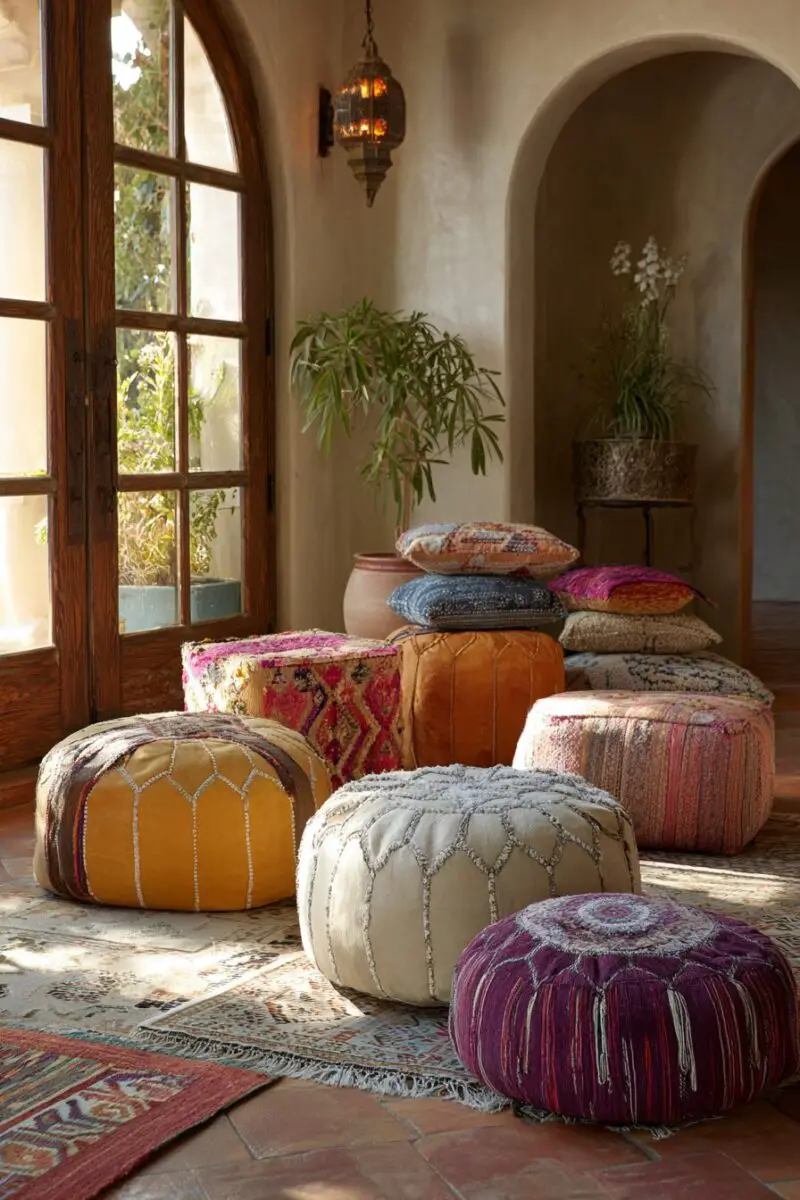
Leather poufs are perhaps the most recognizable and versatile pieces of Moroccan furniture, offering extra seating that can be easily moved wherever needed.
These hand-stitched leather ottomans come in vibrant colors and often feature intricate embroidery or embossing that makes each one a functional work of art.
You can use poufs as impromptu coffee tables, footrests, meditation seats, or even as stylish storage when you choose hollow versions.
For authentic Moroccan lounging, surround a low table with an assortment of floor cushions in complementary patterns and colors to create a comfortable conversation area that encourages relaxed socializing.
Traditional Moroccan homes feature low seating arrangements that foster intimacy and connection—a refreshing alternative to the formal, structured seating of Western living rooms.
The informal nature of pouf and cushion seating arrangements makes guests feel immediately comfortable and creates a laid-back atmosphere perfect for lengthy conversations or casual entertaining.
You can select leather poufs for durability in high-traffic areas and fabric floor cushions with removable covers for spaces where comfort is the priority.
For outdoor spaces, weather-resistant poufs bring the Moroccan riad feeling to your patio or garden, creating exotic lounging areas under the open sky.
The variety of shapes available—from the classic round pouf to hexagonal and square versions—allows you to create interesting visual compositions when grouping multiple pieces.
Children absolutely love these unconventional seating options, making Moroccan-style floor cushions and poufs perfect for family rooms where comfort and durability are equally important.
Madison’s Current Obsessions
Creative Southwest Rustic Decor Ideas You Can't Afford To Miss!Handira Magic: Wedding Blankets That Bring Shimmer to Walls and Beds

The Handira, or Moroccan wedding blanket, is perhaps the most magical textile to emerge from North African craftsmanship, with its neutral base adorned with thousands of tiny mirrors that catch and reflect light.
Traditionally created by Berber mothers for their daughters’ weddings, these spectacular blankets were designed to ward off evil spirits and bring good fortune to new marriages.
You can display a wedding blanket as a dazzling headboard alternative, where the morning sunlight will create a constellation of light reflections across your bedroom.
The weight and substantial texture of authentic Handiras make them excellent sound absorbers, improving room acoustics while adding visual warmth.
Each tiny mirror is hand-sewn into the blanket, representing the countless tears of joy a bride sheds as she leaves her family home—a poetic touch that adds emotional depth to your décor.
The neutral base colors—usually undyed wool in cream, beige, or soft white—make these statement pieces surprisingly versatile and able to complement almost any color scheme.
You can drape a wedding blanket across the foot of your bed for an instant luxury upgrade that adds texture, pattern, and subtle sparkle to your sleeping space.
For a truly spectacular display, hang a Handira on the wall opposite windows where natural light will maximize the blanket’s reflective qualities throughout the day.
The fringe details often found on authentic wedding blankets add another layer of textural interest and movement to these already captivating textiles.
Modern interpretations of the Handira include versions with colored wool bases or sequins instead of mirrors, offering contemporary alternatives that maintain the magical essence of the original.
Madison’s Current Obsessions
Elevating Your Home With 13 Elegant Color SchemesTable Lanterns: Centerpieces That Create Dining Magic

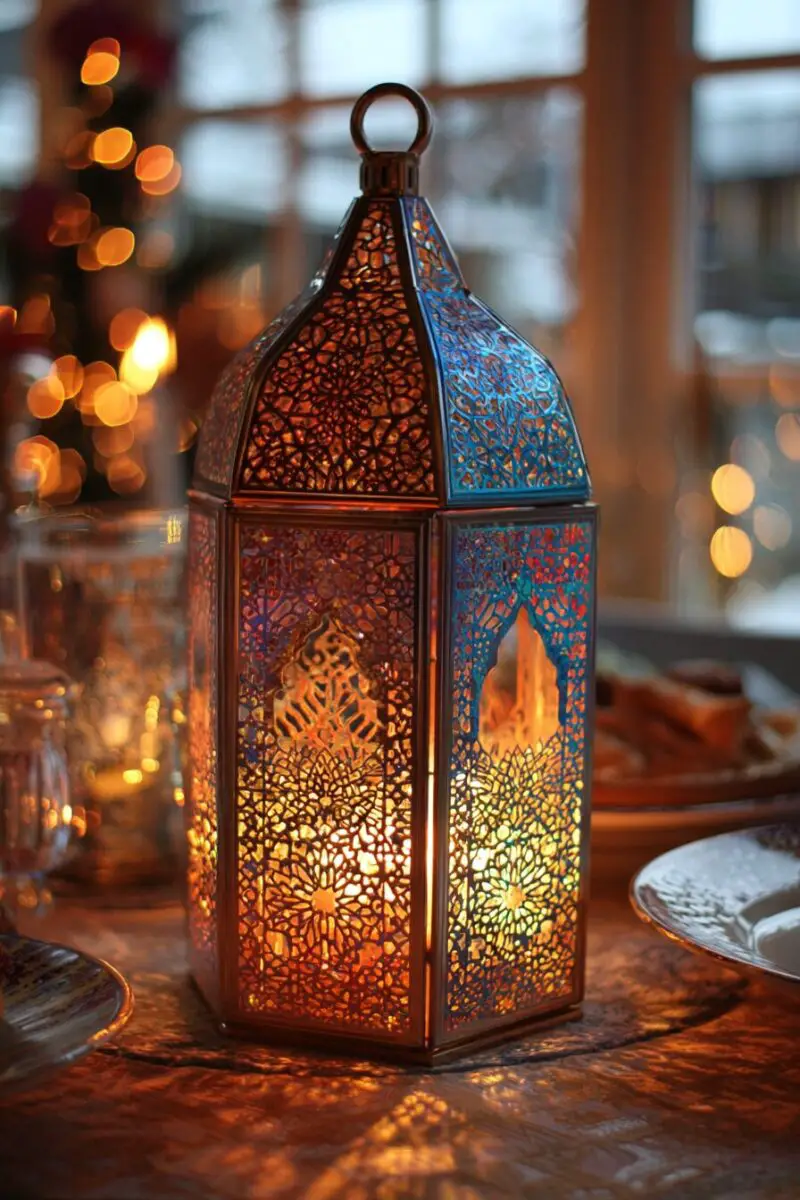
Moroccan table lanterns transform ordinary dining experiences into enchanted feasts with their intimate, focused lighting and jewel-toned glass panels.
Unlike harsh overhead lighting, these tabletop treasures create a flattering glow that makes both the food and the diners look more beautiful.
You can arrange a cluster of different-sized lanterns down the center of a long dining table to create a magical light pathway that eliminates the need for traditional floral centerpieces.
For outdoor dining, Moroccan lanterns provide both practical illumination and protection from breezes that would extinguish regular candles.
The colored glass panels in traditional Moroccan lanterns—ruby reds, cobalt blues, amber yellows, and emerald greens—cast enchanting colored light onto table settings, transforming even simple white dishes into artistic displays.
When entertaining, you can place small tea light lanterns at each place setting as beautiful, functional favors that guests can take home afterward.
The metalwork of authentic Moroccan table lanterns is often embellished with symbols that have deep cultural meaning—stars representing guidance, crescents for prosperity, and geometric patterns symbolizing infinity.
You can use these versatile light sources beyond the dining table—place them on bathroom counters for spa-like ambiance, on bedside tables for romantic reading light, or clustered on coffee tables for cozy evening atmosphere.
For festive occasions, string multiple small Moroccan lanterns along banisters, mantels, or outdoor railings to create celebratory light displays with exotic flair.
The mobility of table lanterns allows you to easily change your lighting scheme to suit your mood or the season—cluster them for winter coziness or spread them throughout the space for summer entertaining.
Madison’s Current Obsessions
How To Infuse Your Home With Mediterranean Charm : 10+ IdeasTextile Wall Hangings: Fabric Art That Transforms Plain Spaces
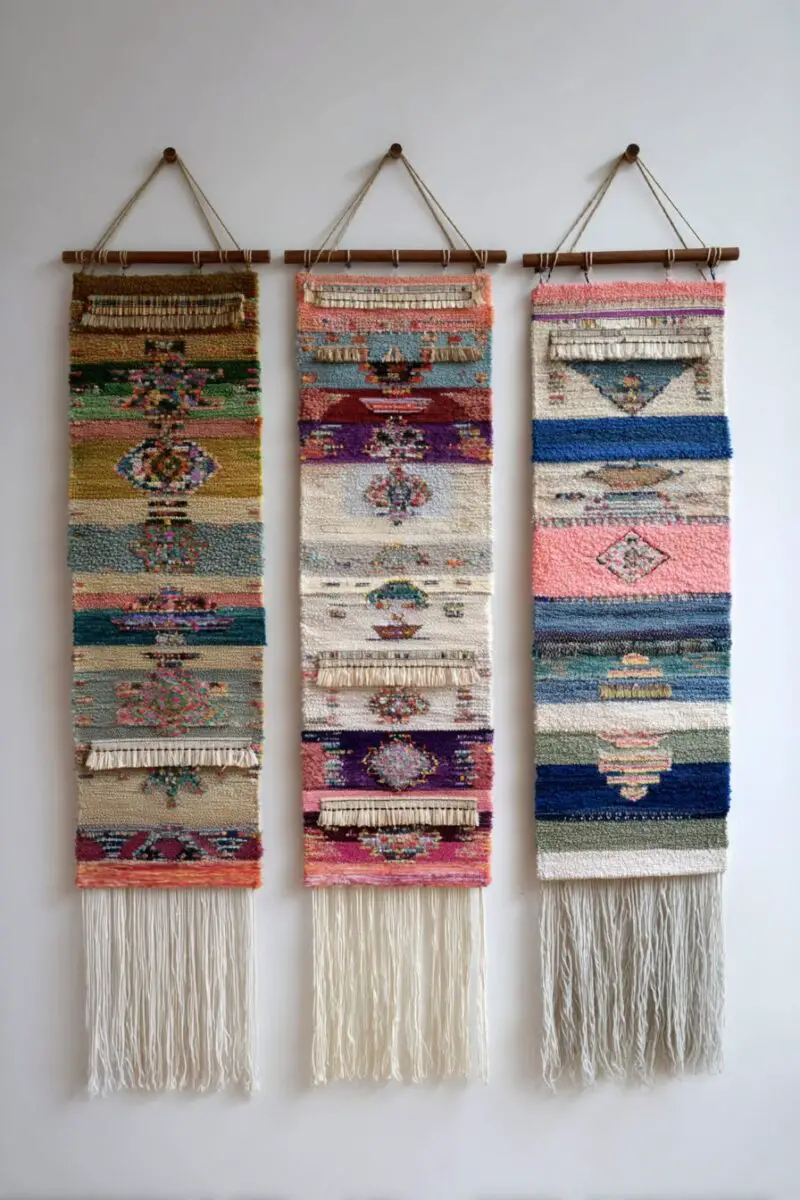
Moroccan textiles displayed as wall hangings instantly add warmth, texture, and cultural richness to stark walls without the permanence or expense of wallpaper or paint.
The vertical display of these intricately patterned fabrics draws the eye upward, making ceilings appear higher and rooms more spacious.
You can frame smaller textile pieces in simple frames for a more formal, art gallery approach, or hang larger pieces with decorative rods for a more relaxed, bohemian feel.
Authentic Moroccan fabrics often feature symbols and patterns that tell stories of the region’s history—from fertility symbols to protective talismans woven into colorful designs.
The handwoven nature of traditional Moroccan textiles means each piece has slight variations and “imperfections” that add character and authenticity to your décor.
You can create a dramatic focal point by hanging a large textile behind your bed instead of a traditional headboard, adding both visual interest and sound-absorbing qualities.
For renters who can’t paint or make permanent changes, textile wall hangings offer a landlord-friendly way to dramatically transform spaces with bold colors and patterns.
The rich textile traditions of Morocco encompass everything from simple striped Kilim weaves to elaborate embroidered Fez fabrics—offering options for minimalist to maximalist design preferences.
You can layer multiple textiles of different sizes and patterns on a large wall to create a gallery-like installation that showcases the diversity of Moroccan craftsmanship.
When selecting colors, consider textiles that pick up accents from other elements in your room for a cohesive look that feels intentional rather than random.
Madison’s Current Obsessions
13 Stylish Rustic Home Decor Ideas For A Cozy SpaceLantern Clusters: Light Installations That Create Atmosphere
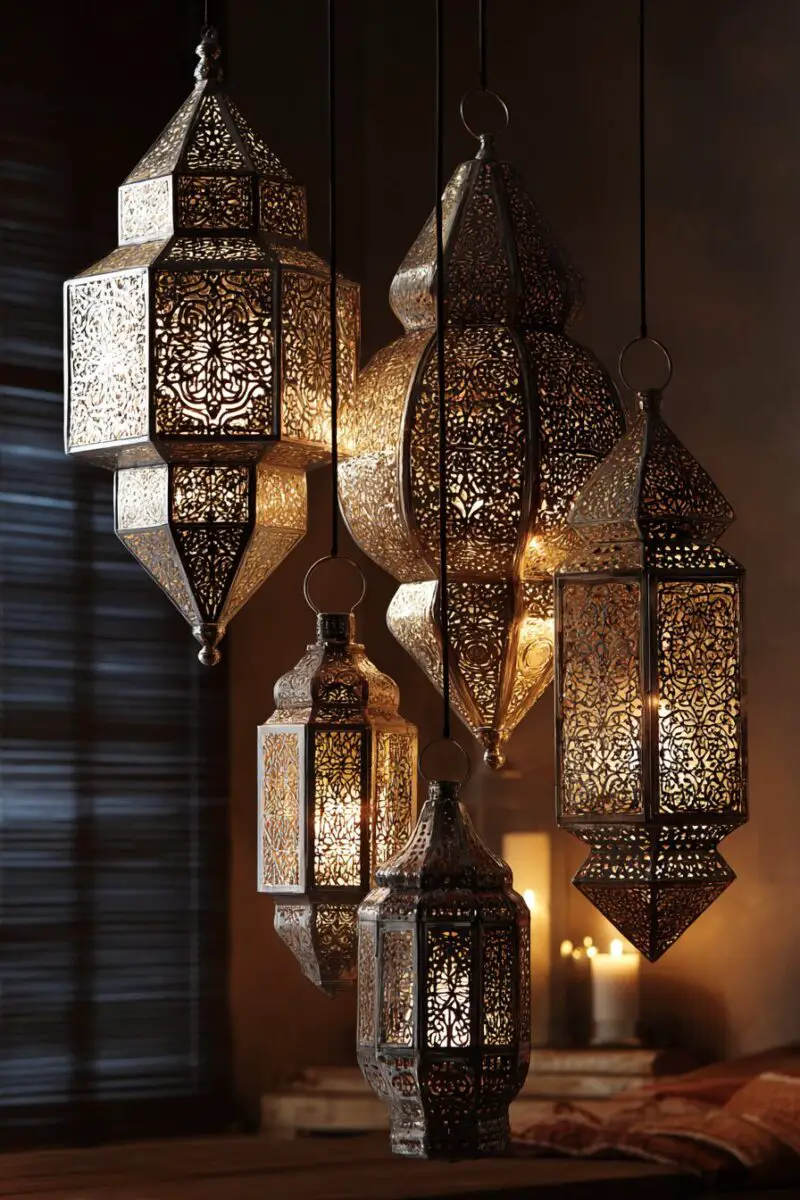
Grouping multiple Moroccan lanterns at varying heights creates a customized light installation that rivals expensive designer lighting at a fraction of the cost.
The overlapping light patterns from clustered lanterns create complex shadow play that adds dimension and mystery to any space.
You can hang lantern clusters in corners that typically remain dark and unused, instantly activating these spaces and making rooms feel larger and more dynamic.
For dramatic effect, consider suspending lanterns at different heights above a stairwell, creating a floating light display that can be enjoyed from multiple floors.
The mix of metallic finishes in a lantern cluster—from polished brass to hammered silver to aged copper—adds rich visual texture even when the lanterns aren’t illuminated.
Using a combination of clear and colored glass panels within your cluster creates an interplay of pure and tinted light that adds complexity to the installation.
You can incorporate battery-operated or electric Moroccan lanterns into areas where wiring would be difficult, expanding your lighting design possibilities beyond ceiling fixtures.
For special occasions, hanging a temporary cluster of lanterns transforms ordinary spaces into exotic venues—perfect for dinner parties or holiday gatherings.
The acoustic properties of metal lanterns create subtle, pleasing sound effects when light breezes move through open windows, adding an auditory dimension to your visual display.
Lantern clusters work beautifully in transitional spaces like foyers, hallways, and stairwells, where they create a thread of Moroccan influence that connects different areas of your home.
Madison’s Current Obsessions
13 Stylish Summer Decorating Ideas for Your SpaceMoroccan-Inspired Throw Pillows: Instant Color That Transforms Furniture
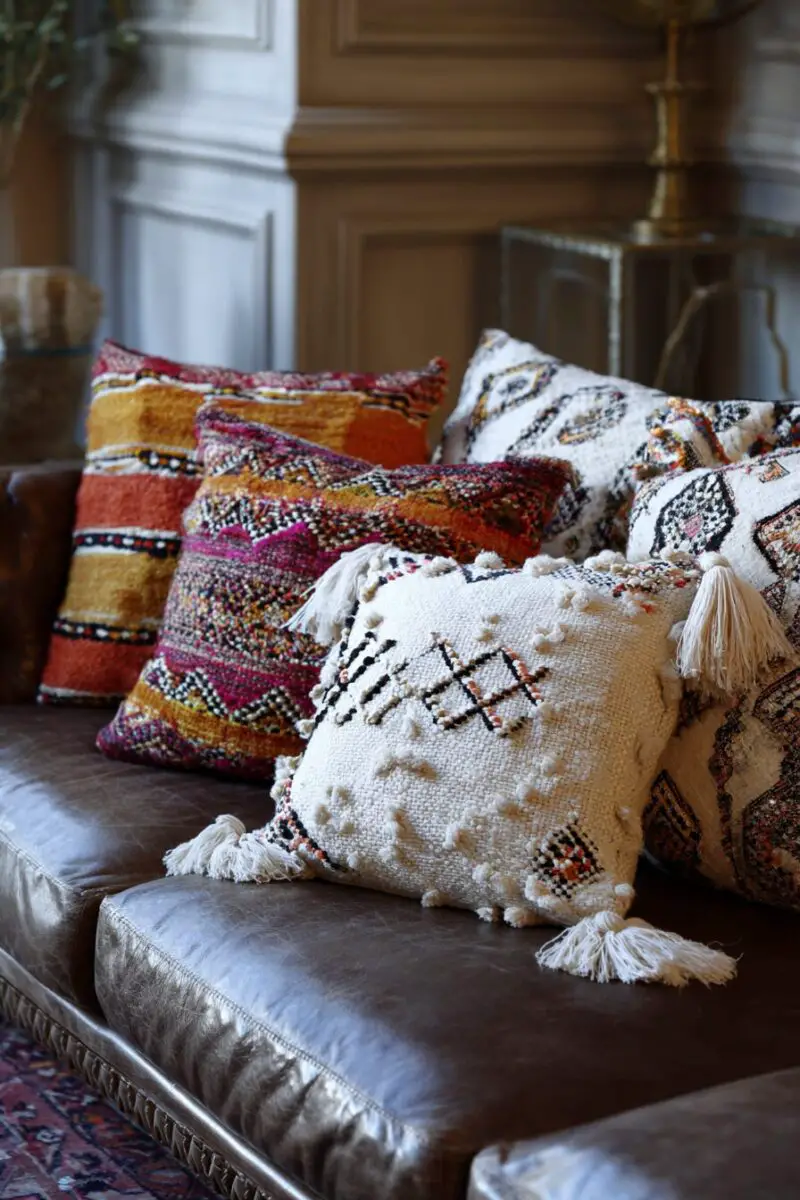
Moroccan throw pillows offer the fastest, most affordable way to inject authentic North African design into your space without committing to larger pieces.
The embroidery techniques used in traditional Moroccan pillows—such as couched metallic threadwork and sequin embellishment—add tactile luxury that mass-produced pillows simply cannot match.
You can layer multiple patterns and sizes on neutral sofas to create a collected-over-time look that feels both bohemian and sophisticated.
For authentic Moroccan style, look for pillows covered in Sabra silk (made from cactus fiber) with its distinctive sheen and durability that actually improves with age.
The geometric patterns common in Moroccan design have timeless appeal that transcends trends, making these pillows wise investments that won’t quickly look dated.
You can seasonally rotate pillow covers—choosing richer, deeper colors for winter months and brighter, lighter versions for summer—while maintaining the Moroccan design theme year-round.
For unexpected charm, place a single statement Moroccan pillow on a plain chair to create an instant focal point that draws attention to otherwise unremarkable furniture.
The handcrafted nature of authentic Moroccan pillows means each piece tells the story of its maker through slight variations in pattern, color saturation, and embellishment techniques.
You can mix pillows made from different Moroccan textiles—combining smooth silk embroidery, nubby wool weaves, and metallic threaded pieces—to create rich textural contrast.
For outdoor spaces, look for Moroccan-inspired pillows in weather-resistant fabrics that bring the exotic aesthetic to patios and garden seating without sacrificing durability.
Madison’s Current Obsessions
How to Decorate Your Small Apartment with Big Style : 13 IdeasLanterns and Plants: Living Displays That Blend Nature and Artistry
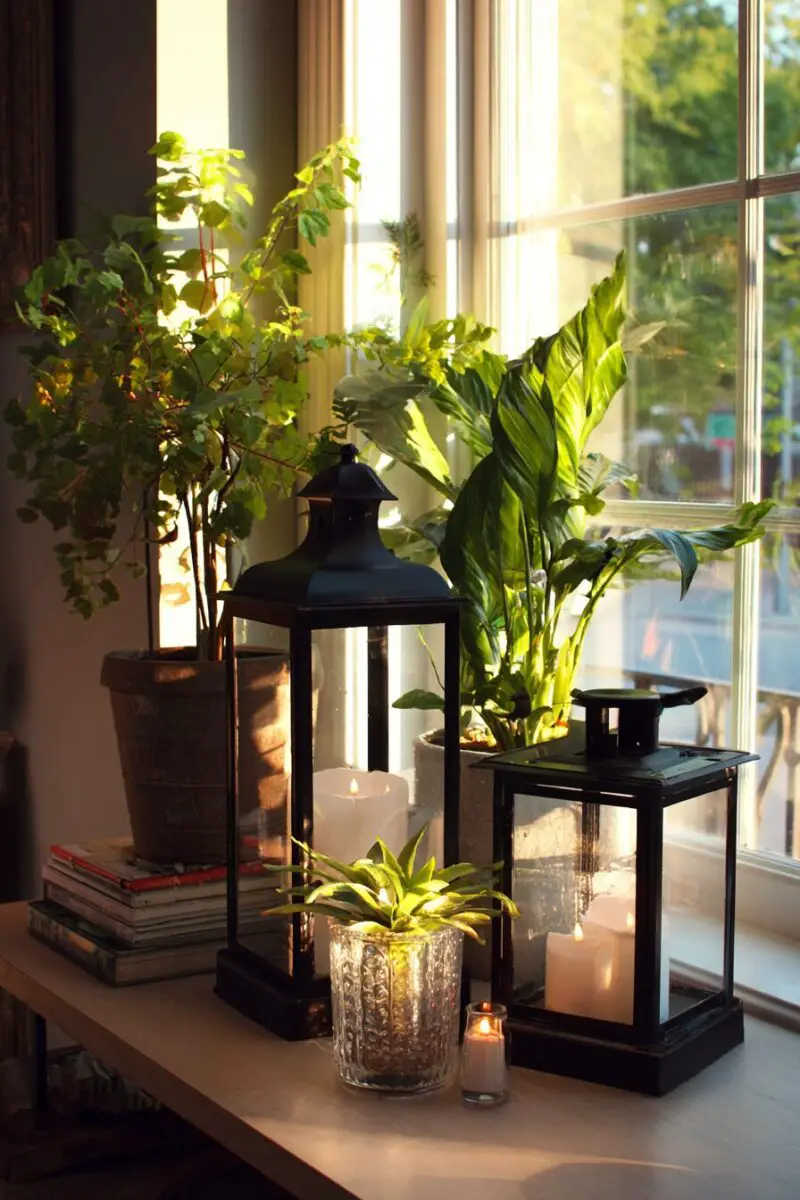
Combining Moroccan lanterns with houseplants creates magical living displays that celebrate the Moroccan love of both natural beauty and handcrafted artistry.
The dappled light filtered through lantern cutouts creates ideal growing conditions for many houseplants that prefer indirect light.
You can place small potted succulents inside larger open lanterns for unexpected living terrariums that blend structure and organic elements.
Trailing plants like string of pearls or pothos look spectacular when allowed to grow around and through lantern openings, creating a deliberately overgrown, romantic aesthetic.
The marriage of metal lanterns and living greenery creates a perfect balance of hard and soft elements that makes spaces feel both designed and natural.
You can hang plant-friendly lanterns near windows where the interplay of natural sunlight, lantern-filtered patterns, and plant shadows creates ever-changing light displays throughout the day.
For a dramatic floor display, place a large Moroccan lantern next to a tall statement plant like a fiddle leaf fig or palm, where the contrasting forms create a compelling design duo.
The metallic finishes of Moroccan lanterns beautifully reflect and amplify the natural green tones of plants, making both elements look more vibrant in combination.
You can create magical outdoor evening spaces by surrounding lantern-lit patios with potted plants that catch the patterned light on their leaves.
For the ultimate Moroccan-inspired plant display, arrange cacti and succulents native to North Africa alongside traditional lanterns to create an authentic desert oasis vignette.
Moroccan design elements bring a timeless, global sophistication to your home that transcends passing trends.
By incorporating these lanterns and textiles, you’re not just decorating—you’re connecting with centuries of artistic tradition and craftsmanship.
Start with just one statement piece and watch how quickly it transforms your space, or dive in with multiple elements for a full Moroccan-inspired sanctuary.
Either way, these magical design elements will infuse your home with warmth, texture, and a touch of exotic mystery that both you and your guests will enjoy for years to come.


